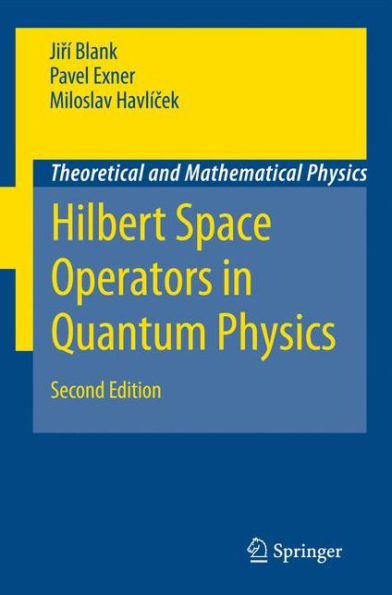Table of Contents
Preface to the second edition, Preface,. 1.Some notions from functional analysis,Vector and normed spaces,1.2 Metric and topological spaces,1.3 Compactness, 1.4 Topological vector spaces, 1.5 Banach spaces and operators on them, 1.6 The principle of uniform boundedness, 1.7 Spectra of closed linear operators, Notes to Chapter 1, Problems 2. Hilbert spaces, 2.1 The geometry of Hilbert spaces, 2.2 Examples, 2.3 Direct sums of Hilbert spaces, 2.4 Tensor products, 2.4 Notes to Chapter 2, Problems 3. Bounded operators, 3.1 Basic notions, 3.2 Hermitean operators, 3.3 Unitary and isometric operators, 3.4 Spectra of bounded normal operators, 3.5 Compact operators, 3.6 Hilbert-Schmidt and trace-class operators, Notes to Chapter 3, Problems 4. Unbounded operators, 4.1 The adjoint, 4.2 Closed operators, 4.3 Normal operators. Self-adjointness, 4.4 Reducibility. Unitary equivalence, 4.5 Tensor products, 4.6 Quadratic forms, 4.7 Self-adjoint extensions, 4.8 Ordinary differential operators, 4.9 Self-adjoint extensions of differential operators, Notes to Chapter 4, Problems 5. Spectral Theory , 5.1 Projection-valued measures, 5.2 Functional calculus, 5.3 The spectral Tudorem, 5.4 Spectra of self-adjoint operators, 5.5 Functions of self-adjoint operators, 5.6 Analytic vectors, 5.7 Tensor products, 5.8 Spectral representation, 5.9 Groups of unitary operators, Notes to Chapter 5, Problems 6. Operator sets and algebra, 6.1 Csub*-algebras, 6.2 GNS construction, 6.3 Wsub*-algebras, 6.4 Normal states on Wsub*-algebras, 6.5 Commutative symmetric operator sets, 6.6 Complete sets of commuting operators, 6.7 Irreducibility. Functions of non-commuting operators, 6.8 Algebras of unbounded operators, Notes to Chapter 6, Problems 7. States and observables, 7.1 Basic postulates, 7.2 Simple examples, 7.3 Mixed states, 7.4 Superselection rules, 7.5 Compatibility, 7.6 The algebraic approach, Notes to Chapter 7, Problems 8. Position and momentum, 8.1 Uncertainty relations, 8.2 The canonical commutation relations, 8.3 The classical limit and quantization, Notes to Chapter 8, Problems 9. Time evolution, 9.1 The fundamental postulate, 9.2 Pictures of motion, 9.3 Two examples, 9.4 The Feynman integral, 9.5 Nonconservative systems, 9.6 Unstable systéme, Notes to Chapter 9, Problems 10. Symmetries of quantum systéme, 10.1 Basic notions, 10.2 Some examples, 10.3 General space-time transformations, Notes to Chapter 10, Problems 11. Composite systems, 11.1 States and observables, 11.2 Reduced states, 11.3 Time evolution, 11.4 Identical particles, 11.5 Separation of variables. Symmetries, Notes to Chapter 11, Problems 12. The second quantization, 12.1 Fock spaces, 12.2 Creation and annihilation operators, 12.3 Systems of noninteracting particles, Notes to Chapter 12, Problems 13. Axiomatization of quantum theory, 13.1 Lattices of propositions, 13.2 States on proposition systems, 13.3 Axioms for quantum field theory, Notes to Chapter 13, Problems 14. Schrödinger operators, 14.1 Self-adjointness, 14.2 The minimax principle. Analytic perturbations, 14.3 The discrete spectrum, 14.4 The essential spectrum, 14.5 Constrained motion, 14.6 Point and contact interactions, Notes to Chapter 14, Problem 15. Scattering theory, 15.1 Basic notions ,15.2 Existence of wave operators, 15.3 Potential scattering, 15.4 A model of two-channel scattering, Notes to Chapter 15, Problems 16. Quantum waveguides, 16.1 Geometric effects in Dirichlet stripes, 16.2 Point






